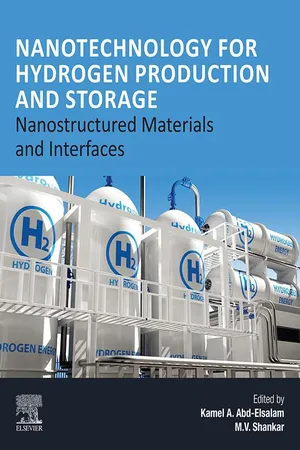
Nanotechnology for Hydrogen Production and Storage
Nanostructured Materials and Interfaces
- 660 pages
- English
- ePUB (mobile friendly)
- Available on iOS & Android
Nanotechnology for Hydrogen Production and Storage
Nanostructured Materials and Interfaces
About This Book
Nanotechnology for Hydrogen Production and Storage: Nanostructured Materials and Interfaces presents an evaluation of the various nano-based systems for hydrogen generation and storage. With a focus on the challenges and recent developments, the book analyses nanomaterials with the potential to boost hydrogen production and improve storage.
The book assesses the potential improvements to industrially important hydrogen production technologies by the way of better surface-interface control through nanostructures of strategical composites of metal oxides, metal chalcogenides, plasmonic metals, conducting polymers, carbonaceous materials and bio-interfaces with different types of algae and bacteria. The efficiency of various photochemical water splitting processes to generate renewable hydrogen energy are reviewed, with a focus on natural water splitting via photosynthesis, and the use of various metallic and non-metallic nanomaterials in anthropogenic/artificial water splitting processes is analyzed. The potential of nanomaterials in enhancing hydrogen generation in dark- and photo-fermentative organisms is also explored. Finally, the book critically evaluates various nano-based systems for hydrogen generation, as well as significant challenges and recent advances in biohydrogen research and development.
Nanotechnology for Hydrogen Production and Storage is a valuable reference for student and researchers working in renewable energy and interested in the production and storage of hydrogen and may be of interest to interdisciplinary researchers in the areas of environmental engineering, materials science, and biotechnology.
- Synthesizes the latest advances in the field of nanoparticles for hydrogen production and storage, including new methods and industry applications
- Explains various methods for the design of nanomaterials for hydrogen production and storage
- Identifies the strengths and weaknesses of different nanomaterials and approaches
- Explores hydrogen production via photocatalytic, electrocatalytic, and biological processes
Frequently asked questions
Information
Table of contents
- Cover image
- Title page
- Table of Contents
- Copyright
- List of contributors
- About the editors
- Preface
- Chapter 1. Next-generation nanostructures and material interfaces for enhanced hydrogen generation and storage: a note from the editors
- Part 1: Nanomaterials for water splitting
- Part 2: Nanomaterials for biohydrogen production
- Part 3: Nanomaterials for hydrogen storage
- Index